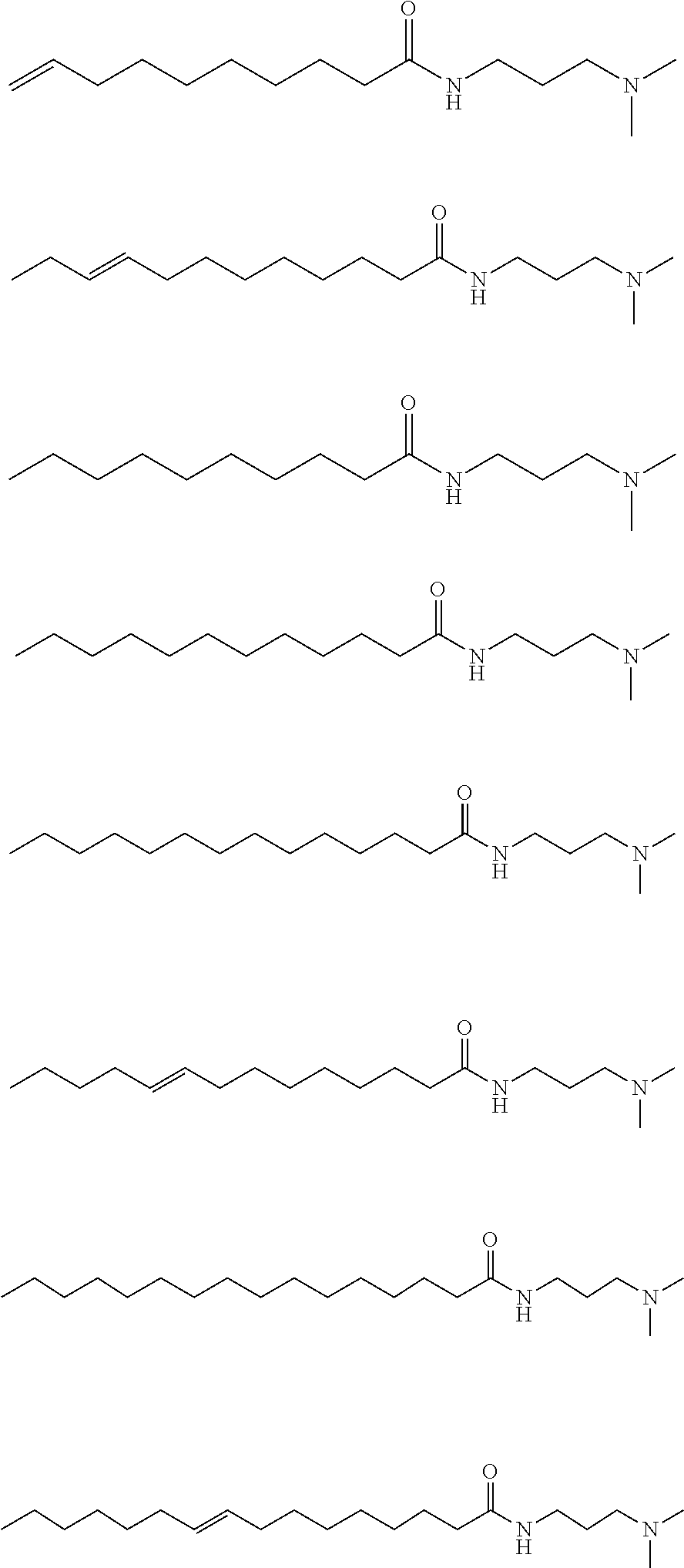Aqueous hard surface cleaners based on terpenes and fatty acid derivatives
a technology of fatty acid derivatives and cleaners, applied in the field of aqueous cleaners, can solve the problems of inability to change the appearance of permanent ink marks on hard surfaces, solvent-based products are typically less than satisfactory in removing permanent marks from hard surfaces, and black ink is particularly difficult to remove, so as to extend the reach of commercial all-purpose cleaners
- Summary
- Abstract
- Description
- Claims
- Application Information
AI Technical Summary
Benefits of technology
Problems solved by technology
Method used
Image
Examples
example 1a
thesis of Soybean Oil and 1-Butene
[0101]A clean, dry, stainless-steel jacketed 5-gallon Parr reactor equipped with a dip tube, overhead stirrer, internal cooling / heating coils, temperature probe, sampling valve, and relief valve is purged with argon to 15 psig. Soybean oil (SBO, 2.5 kg, 2.9 mol, Costco, Mn=864.4 g / mol, 85 weight % unsaturation, sparged with argon in a 5-gal container for 1 h) is added to the Parr reactor. The reactor is sealed, and the SBO is purged with argon for 2 h while cooling to 10° C. After 2 h, the reactor is vented to 10 psig. The dip tube valve is connected to a 1-butene cylinder (Airgas, CP grade, 33 psig headspace pressure, >99 wt. %) and re-pressurized to 15 psig with 1-butene. The reactor is again vented to 10 psig to remove residual argon. The SBO is stirred at 350 rpm and 9-15° C. under 18-28 psig 1-butene until 3 mol 1-butene per SBO olefin bond are transferred into the reactor (˜2.2 kg 1-butene over 4-5 h).
[0102]A toluene solution of [1,3-bis-(2,4,...
example 1b
[0105]The procedure of Example 1A is generally followed with 1.73 kg SBO and 3 mol 1-butene / SBO double bond. An aliquot of the product mixture is transesterified with sodium methoxide in methanol as described above. The products (by GC) are: methyl 9-decenoate (24 wt. %), methyl 9-dodecenoate (18 wt. %), dimethyl 9-octadecenedioate (2 wt. %), and methyl 9-octadecenoate (2 wt. %).
example 1c
[0106]The procedure of Example 1A is generally followed with 1.75 kg SBO and 3 mol 1-butene / SBO double bond. An aliquot of the product mixture is transesterified with sodium methoxide in methanol as described above. The products (by GC) are: methyl 9-decenoate (24 wt. %), methyl 9-dodecenoate (17 wt. %), dimethyl 9-octadecenedioate (3 wt. %), and methyl 9-octadecenoate (2 wt. %).
PUM
| Property | Measurement | Unit |
|---|---|---|
| wt. % | aaaaa | aaaaa |
| wt. % | aaaaa | aaaaa |
| headspace pressure | aaaaa | aaaaa |
Abstract
Description
Claims
Application Information
 Login to View More
Login to View More - R&D
- Intellectual Property
- Life Sciences
- Materials
- Tech Scout
- Unparalleled Data Quality
- Higher Quality Content
- 60% Fewer Hallucinations
Browse by: Latest US Patents, China's latest patents, Technical Efficacy Thesaurus, Application Domain, Technology Topic, Popular Technical Reports.
© 2025 PatSnap. All rights reserved.Legal|Privacy policy|Modern Slavery Act Transparency Statement|Sitemap|About US| Contact US: help@patsnap.com



